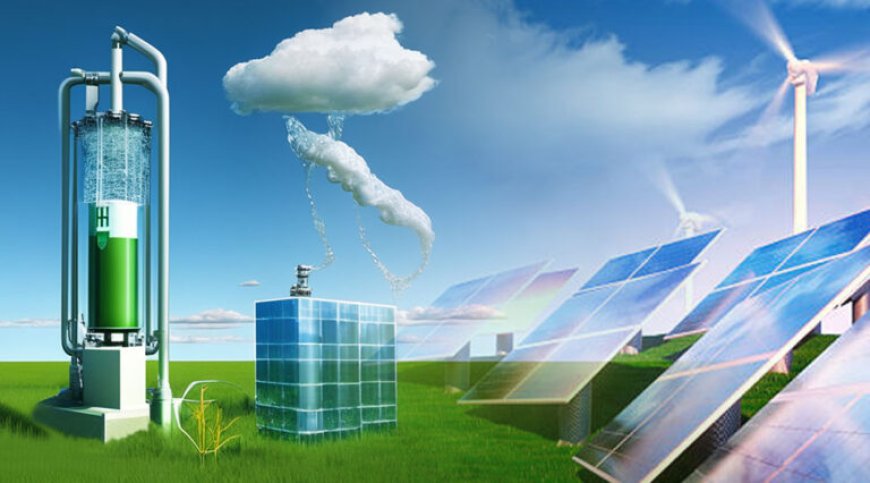Transforming Energy: India’s National Green Hydrogen Mission and Its Global Impact
At a time when the entire world is racing toward sustainable energy, India is not just keeping pace—it's setting the course for a cleaner, greener future.

At a time when the entire world is racing toward sustainable energy, India is not just keeping pace—it's setting the course for a cleaner, greener future.
The National Green Hydrogen Mission (NGHM), launched in 2023, is India's bold answer to the global call for decarbonisation.
With its ambitious targets and forward-thinking approach, this mission is poised to transform the country's energy landscape and establish India as a global leader in green hydrogen production.
Soon, there might be a future where industries, vehicles, and homes run on completely emission-free fuel—this is the promise of Green Hydrogen.
India is not just envisioning this future because it's actively building it. By harnessing the immense potential of renewable energy, the NGHM aims to revolutionise how India produces, consumes, and exports clean energy while significantly cutting down its carbon emissions. This mission is more than just an initiative—it's a nationwide transformation that could ripple globally.
India's Ambitious Green Hydrogen Targets
The National Green Hydrogen Mission outlines a bold vision for the future of clean energy in India. By 2030, the mission aims to achieve a production capacity of 5 million metric tonnes per annum (MMTPA) of Green Hydrogen with the help of independent power producers like AMPIN Energy Transition.
This aligns with India's broader climate and sustainability goals, including reducing carbon emissions by 1 billion tonnes by the end of this decade and reaching net-zero emissions by 2070.
India plans to harness its vast renewable energy resources, such as solar and wind power, to achieve these targets. By 2030, India aims to have a non-fossil fuel-based energy capacity of 500 GW, with 125 GW dedicated to supporting the production of Green Hydrogen.
This large-scale shift toward renewable energy decreases the country's reliance on fossil fuel imports and improves energy security and resilience. Additionally, it opens up new job opportunities, with an estimated 600,000 jobs expected to be created as a result of the mission.
Key Projects and Investments Under the NGHM
The Indian government has made substantial commitments to build a thriving Green Hydrogen ecosystem. As part of the NGHM, an initial outlay of ₹197.44 billion has been allocated, with a major portion₹174.9 billion—dedicated to the Strategic Interventions for Green Hydrogen Transition (SIGHT) program.
The SIGHT program aims to incentivise the domestic production of Green Hydrogen and electrolysers, critical components used in the hydrogen production process.
Additionally, the 2024 Union Budget allocated ₹600 crore specifically to support the mission, marking a significant 102% increase from the previous year's allocation of ₹297 crore. This financial commitment signals the government's serious intent to accelerate the Green Hydrogen revolution.
The Indian government is not stopping at funding alone. Pilot projects across key sectors, such as steel production and transportation, are already underway.
These initiatives will test the real-world applications of Green Hydrogen, creating a blueprint for large-scale implementation in the near future. These pilot projects are critical because they will help determine the commercial viability of Green Hydrogen in industries that are traditionally dependent on fossil fuels.
Challenges and Opportunities Ahead
While the National Green Hydrogen Mission presents tremendous opportunities, it also faces challenges that need to be addressed.
One of the biggest hurdles is the cost of Green Hydrogen production, which remains higher compared to traditional hydrogen due to the price of renewable energy and electrolysis technologies.
However, as technology advances and companies like AMPIN Energy Transition do more R&D on green hydrogen production, these costs are expected to come down significantly.
India will also need to invest in infrastructure development, such as pipelines, storage facilities, and transportation systems, to ensure the seamless integration of Green Hydrogen into its energy mix. Collaboration with the private sector will be essential in overcoming these logistical challenges.
Despite these challenges, the potential rewards are enormous. By achieving the targets set under the NGHM, India could significantly reduce its reliance on fossil fuels, enhance energy security, create jobs, and establish itself as a global Green Hydrogen market leader.
A Path to a Greener Future
India's National Green Hydrogen Mission represents a bold step toward a sustainable and resilient energy future. By harnessing the power of Green Hydrogen, India aims to decarbonise key industries, reduce carbon emissions, and enhance energy security—all while creating new jobs and driving economic growth.
The global impact of this mission cannot be overstated, as it positions India and its independent power producers such as AMPIN Energy Transition at the forefront of the clean energy transition, inspiring other nations to follow suit. The journey to a greener future has begun, and India is leading the way.
What's Your Reaction?











![Prima Ease CBD Gummies [I've Tested] TRUTH EXPOSED!](https://news.bangboxonline.com/uploads/images/202412/image_430x256_6766ac778f8ee.jpg)










